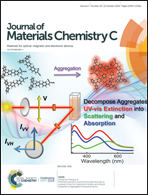Dirac–Weyl semimetal phase in noncentrosymmetric transition metal monochalcogenides MoTe and WTe†
Abstract
We investigated the topological properties of hexagonal transition metal monochalcogenides (TMMs) MoTe and WTe by combining first-principles calculations, the Wannier-based tight-binding method and the low energy k·p effective model. The topological properties are identified by calculating the node chirality, surface states and surface Fermi arcs. Our calculations revealed that both MoTe and WTe are nodal line semimetals in the absence of spin–orbit coupling (SOC). When considering the SOC, the nodal semimetal is transformed into a Dirac–Weyl semimetal, which hosts simultaneously Dirac fermions and Weyl fermions. Two Dirac nodes on the kz axis are protected by threefold rotation symmetry. Twelve pairs of Weyl nodes on the kz ≠ 0 planes are related by C3 rotation symmetry and lie below the Fermi level, which makes them accessible by conventional Angle-resolved photoemission spectroscopy (ARPES) measurement. The separation of Weyl points in reciprocal space, and the length of the surface Fermi arc, is of the order magnitude of 0.1 Å−1, which makes them easy to observe experimentally. In addition, the Dirac–Weyl semimetal phase is robust against external strain. Our findings are important for studying the interaction between Dirac fermions and Weyl fermions in a single material and useful for realizing possible applications in future topological electronic devices.



 Please wait while we load your content...
Please wait while we load your content...